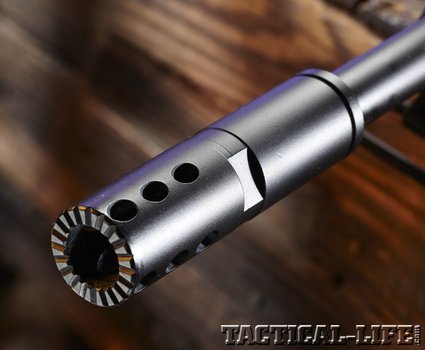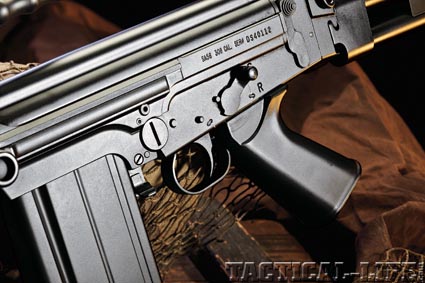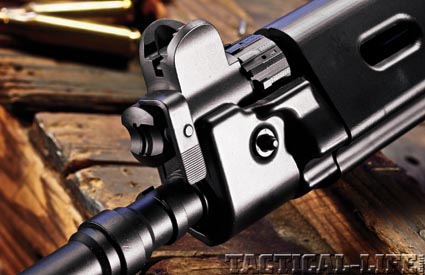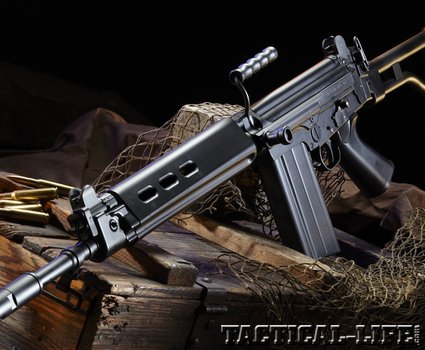Capturing the spirit and bravery of the Belgian paratroopers in Operation Dragon Rouge during the Congo Crisis in the 1960s, DS Arms’ SA58 Para Congo rifle in 7.62x51mm offers operators a compact and powerful semi-automatic variant
While the AK may rightly claim the title of being the most prolific military arm of the modern world, the 7.62x51mm Belgian FAL (which stands for Fusil Automatique Léger or “light automatic rifle”) from famed arms-maker Fabrique Nationale is certainly in the running for the number two spot. Adopted for service by numerous countries during the Cold War era of the 20th century and produced in dizzying numbers, the FAL in its many iterations has in some cases served on both sides of a regional conflict or proxy war.
The Congo Crisis
Advertisement — Continue Reading Below

The barrel has a Belgian Short Flash Suppressor” that features a serrated face and four groups of three venting ports around its circumference
A classic example of this is what is commonly known as the Congo Crisis, which developed during the years of political unrest in the former Belgian colony, following Belgium’s official declaration of Congo’s independence in 1960. The threat of civil war appeared almost immediately, leading the United Nations to move peacekeeping troops into the country and to maintain them there for three years.
And when it comes to a single continent where there appears to be a notable preponderance of FALs (as well as other 7.62x51mm military arms), Africa seems to be a particularly accommodating home to these prolific designs. This is likely due, in no small part, to the vast numbers produced, as well as the unique relationship between many of these former colonies and the Western European nations they were affiliated with. From the colonial to the post-colonial era, the transitional phases for these nations were unfortunately often punctuated with violence and in many cases led to armed conflicts.
Advertisement — Continue Reading Below
Unfortunately, less than a month after the withdrawal of UN troops from Congo, fighting broke out down ethnic and political divides. As a rebel antigovernment faction violently gained control of large sections of the nation, foreign governments warned their citizens to leave the country for their own safety. The crisis spread to Stanleyville, where large numbers of Europeans and Americans were located, which was overrun and captured by rebels. Shortly, a number of these foreigners were taken hostage. This led to the Congo Crisis.
In fear of the hostages’ lives, the United States and Belgium jointly developed an intervention plan dubbed “Dragon Rouge,” which entailed having American air transports move a small force of Belgian paratroopers into Congo to intervene on behalf of the hostages if negotiations with the rebels failed (which they ultimately did). While some hostages were brutally killed by rebels during the rescue, operation Dragon Rouge was ultimately a success. It resulted in the rescue and removal of the majority of the hostages, due to the consummate skill and top-tier equipment of the Belgian paratroops delivered with the help of American air power.
Tools Of The Trade
Advertisement — Continue Reading Below
When discussing the Belgian military’s excellent equipment, undoubtedly the conversation must turn to the FAL. Home of Fabrique Nationale, Belgium fielded this ubiquitous Cold War–era rifle beginning in the mid 1950s. The earliest variants were relatively straightforward rifle versions of the design, with the nation later adopting “Para” carbine versions that employed a shorter barrel and a folding stock assembly (to allow its paratroopers easier accommodation inside cramped aircraft and other vehicles).
The Para variant of the FAL represented something of an engineering feat, requiring more than simply “chopping” the barrel and throwing on a folding stock. As the original FAL design employed a recoil spring assembly jutting into the buttstock, the Para FAL designers moved the recoil spring assembly into the top cover above the receiver, allowing the use of a full folding stock assembly. To accommodate the spring in this location, the bolt carrier was internally bored out deeper to allow the spring assembly to sit inside the deepened recess.
As a result, designers were able (after earlier design attempts, which featured an underfolding stock configuration) to settle upon a rigid side-folding design that offered the dual benefits of a full-stock profile and cheekweld with the ability to fold along the right side of the receiver. The folding mechanism itself featured a “tongue-in-groove” system where downward pressure on the stock body against spring pressure released the stock to fold alongside the receiver.
Advertisement — Continue Reading Below
The Para FAL retained the numerous positive characteristics of the basic FAL rifle. One of the most notable of these is the finely adjustable gas system. The piston-operated system, retained by a gas plug on the forward face of the front sight base/gas block, is operated by gas bled off the bore through a port. A circular gas regulator sleeve (around the gas tube and behind the front sight) can be rotated to access a variety of differently sized gas ports. This allows the user to closely regulate the amount of gas allowed into the gas system, modifying the rifle to fire a wide variety of ammunition types and function while even heavily fouled.
The other very unique characteristic of the FAL rifle is its locking mechanism. Rather than employing the more commonly encountered rotating bolt system, it instead features a tilting-block locking mechanism. In this system, the rear face of the bolt assembly fits into a recess inside the stressed-steel receiver just to the rear of the magazine well. As the bolt carrier is driven rearward by gas pressure, the bolt’s rear ledge is lifted and unlocked.
The rest of the design is reasonably straightforward to anyone familiar with a repeating, magazine-fed 7.62x51mm rifle. The FAL employs steel 20-round magazines (although newly manufactured variants in higher and lower capacities are available), and the receiver arrangement is made up of two sections: an upper section (topped off with the top cover) that houses the bolt and bolt carrier assemblies, as well as the mag and bolt release levers; and a lower receiver that accepts the stock, pistol grip and trigger assembly and hosts the rotating safety lever.
Advertisement — Continue Reading Below
DS Arms
Although the Cold War may be currently relegated to the dustbin of history, the FAL has lived well beyond that era. Still seen in conflicts today, the FAL has even found a permanent home here in the U.S. thanks to the efforts of DS Arms. Carrying on the heritage of FAL-pattern rifle manufacturing, DS Arms FALs are considered by many to not only rival the quality of the original Fabrique Nationale rifles but also possibly exceed it. But how did DS Arms get in to the FAL business on this side of the Atlantic?
DS Arms (named for its founder and owner, Dave Selvaggio) began life in the late 1980s and soon developed a reputation for digging up rare and interesting FAL parts from around the world and offering them for sale. As part of this relentless focus on the FAL rifle, the company was fortunate enough to learn in the mid-1990s that the Steyr Arms plant in Austria was planning on selling off its licensed FAL manufacturing equipment and spare parts as surplus. As a result, DS Arms was able to purchase the original blueprints, tools and parts for the Austrian StG 58, Austria’s variant of the FAL rifle.
Advertisement — Continue Reading Below
Shipping all this to its location in Illinois, DS Arms soon had the distinction of manufacturing U.S.-made variants of the FAL rifle on original, proper-spec tooling. This line of metric-pattern rifles came to be known as the SA58 series, which quickly became renowned for its exceptional quality and attention to detail. And, the line was not simply a direct re-creation of the StG 58 but rather a modernized and updated version of the classic design.
The heart of the SA58 is the semi-automatic-only receiver. Machined from a billet of 4140 steel, the receiver requires a manufacturing process that takes eight full hours (including heat-treatment and finishing). The company offers the receivers in two versions: Type I and Type II. The Type I is patterned after the original FN receiver, and the Type II is patterned after FN’s later receiver design, which features a modified lightening cut near its rear-lower portion.

The heart of every SA58 is the stressed steel receiver. The sample shown is the “Type I” variation patterned after early-era FAL rifles.
Advertisement — Continue Reading Below
Gun Details
While recently perusing DS Arms’ website, I spotted a variant dubbed the “SA58 Para Congo.” A close look at the rifle’s specs and overall design brought to mind the Congo Crisis and the daring of the Belgian paratroopers. Inspired by the chance to go hands-on with a semi-automatic rifle that closely mirrored the weapon that these renowned warriors had at one time carried, I contacted DS Arms and inquired about the availability.
I was in luck: They did have some completed rifles in stock, and I soon had a sample in my hands. Weighing in at 9.85 pounds, the 7.62mm rifle featured the early Type I receiver configuration and a lightweight aluminum lower receiver. Although a 16-inch barrel is also offered, I opted for the 18-inch barrel length. Both bipod-cut barrel types feature a “Belgian Short Flash Suppressor” with a serrated face and four groups of three venting ports located at the 1, 5, 7 and 11 o’clock positions. A rotating forward sling swivel is mounted just forward of the gas block/front sight assembly.
Advertisement — Continue Reading Below
The Para Congo has a full-length gas system that sits under a molded fiberglass handguard, which is cut for a bipod and features three large cooling ports on each of its upper-forward sides. Patterned like the original Para FAL, the Para Congo’s stock features a metal “skeleton” body that offers a full cheekweld and a 14-inch length of pull. Employing a tongue-in-groove lock, it can be unlocked through downward pressure on the stock body. This allows it to fold along the right side of the rifle. To keep weight to a minimum, it is manufactured from aluminum. The rifle also features the familiar FAL folding carry handle at the forward ring of the receiver. The smooth synthetic pistol grip has the classic “belled”-shape body that is hand-filling and comfortable.

The highly adjustable gas piston system’s regulator sleeve features numerous adjustment settings for fine tuning the Para Congo’s operation.
Once home with the rifle, I gave it a more thorough inspection. Like with my past experiences with DS Arms’ products, I found the fit and finish of the Para Congo to be superb. The exterior of the rifle has a deep black DuraCoat finish, and the action cycled smoothly, with an empty magazine locking the action open. A few dry fires of the trigger revealed a gritty 9.25-pound pull but with a discernable break. The one 20-round magazine provided with the Para Congo has the same DuraCoat finish on its exterior. After a quick cleaning and lubrication, I took the rifle out with a selection of Black Hills, Federal and Winchester ammunition to put it through its paces.
Range Time
Although DS Arms makes a very nice scope rail mount for its FAL rifles, I felt it would be more appropriate to test this rifle the way it would have been used—with iron sights only. Could I get better groups with an optic? Sure, but to me, that was not really the point of this test. So I set out to see what I could wring out of the rifle with just the open sights.
Settled in on the bench with my target set at 100 yards, I fired a few groups to sight in the rifle. I quickly became accustomed to the excellent iron sights of the rifle (made up of a wing-protected post front sight and a Belgian-type dual peep aperture rear designated for 150 and 250 meters). Once sighted in, I began running the Para Congo for groups. About 25 rounds in, I had one failure to fully eject, with the fired case pushed against the forward edge of the ejection port by the bolt. As this was a brand new gun, I suspected it was part of the break-in process. So I marked my logbook and continued firing.
As I expected, the gun ran like a champ for the rest of the test, which entailed a few hundred rounds. And I was surprised by the gun’s accuracy, particularly with open sights. Although the majority of the groups were around the upper 2- to 3-inch range, I got some tight “best” groups (including a 1.55-inch group with the 150-grain Federal load). Being that I was fighting a 9.25-pound trigger pull and using iron sights, I was extremely impressed with the results. Recoil was manageable but notable (no surprise, considering it is a carbine-length 7.62mm with a metal, folding stock). I did note one minor quirk: The carry handle could not fully fold down alongside the right of the receiver when the stock was folded.
Conclusion
The SA58 Para Congo from DS Arms offers U.S. gun enthusiasts a chance to own an arm affiliated with the brave Belgian paratroopers that pulled off the daring Dragon Rouge raid during the dark days of the Congo Crisis. Combining impressive power with compact handling characteristics and DS Arms’ trademark attention to quality manufacturing, the Para Congo not only ties itself to the remarkable history of the FAL design but also offers users a capable 7.62mm carbine that’s capable of holding its own today. For more information, call 847-277-7258 or visit dsarms.com.























